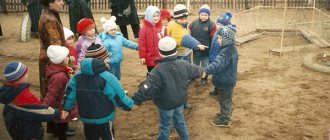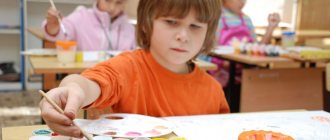First of all - mode
School dictates a certain rhythm of life: early rise, lessons, breaks, homework, etc. It usually takes several months to get used to a new daily routine, so it is necessary to introduce changes into the baby’s usual rhythm of life long before the first bell rings for him. call.
If a child goes to kindergarten or at least to a short-term group, then he is already accustomed to a certain schedule. Zero groups and preparatory courses at schools help “home” children adjust to the working rhythm.
Even if the baby has a free morning and doesn’t have to go anywhere, this is not a reason to break the routine. You should start waking up your child at least 15 minutes before the scheduled time of rising. After all, even if the baby went to bed on time, he will not be able to jump out of bed at the first request. By the way, orthopedists advise that before getting out of bed, soak up a little, stretch while lying down, and when you get up, bend a few times in different directions and stretch again, this time upward.
A great exercise is squats. They tone all the muscles and allow the body to finally wake up. To interest the toddler, adults can do exercises with him. If it takes place in the form of a game, then from a tedious “obligation” it will quickly turn into an exciting activity, and the little one will no longer have to remind him about it.
When scheduling developmental classes, do not get carried away with quantity. A preschooler should have 2-3 hours for walks and time not only for games, but also for him to be alone with himself.
Even if your baby does not sleep during the day, still invite him to lie down for at least an hour after lunch. Otherwise, he may become overexcited in the evening. Also at this time you can play “quiet” games, read a book, sculpt, or draw.
After afternoon tea, it’s time for active rest - walks, outdoor games. After dinner, start putting your little one into “sleep” mode. It is best to read a book at this time, watch a calm cartoon, draw, or sculpt. These daily rituals will help you get into the mood for sleep and calm your mind. A 6-year-old child should sleep at least 10 hours a day.
If you want to “load” your little one with additional activities, for example, dancing, it is better to do this a year before school or wait until the child goes to second grade. Otherwise, there is a risk that the first grader will not be able to cope with the increased workload.
Regime according to the program “from birth to school”
Daily routine in groups. Program “From birth to school” edited by N.E. Veraks, T.S. Komarov, M.A. Vasiliev
Daily routine for children of the 1st junior group
7.30-8.00 – reception of children, independent activities
8.00-8.20 – preparation for breakfast, breakfast
8.20-9.00 – independent activity
8.30-9.00 – organized educational activities (by subgroups)
9.00-9.20 – preparation for the walk
9.20-11.20 – walk, second breakfast
11.20-11.45 – return from a walk, independent activity, preparation for lunch.
11.50-12.20 – lunch
12.20-12.30 – quiet games, getting ready for bed
12.30-15.00 – sleep
15.00-15.15 – gradual rise, independent activity
15.15-15.25 – afternoon tea
15.25-16.15 – independent activity
15.45-16.15 – organized educational activities (by subgroups)
16.15-16.30 – preparation for the walk
16.30-19.00 – walk, gradual departure of children home
Daily routine for children of the 2nd junior group
7.00-8.20 – reception, examination, games, morning exercises
8.20-9.00 – preparation for breakfast, breakfast
9.00-10.00 – organized educational activities
10.00-12.00 – preparation for the walk, walk (games, observations, work), second breakfast
12.00-12.20 – return from a walk, game
12.20-12.50 – preparation for lunch, lunch
12.50-15.00 – getting ready for bed, napping
15.00-15.25 – gradual ascent, air and water procedures
15.25-15.50 – preparation for afternoon tea, afternoon snack
15.50-16.20 – games, independent activities
16.20-16.35 – reading fiction
16.40-19.00 – preparation for the walk, walk, gradual departure of children home
Daily routine for middle group children
7.00-8.25 – reception and examination of children, games, duty, morning exercises
8.25-8.55 – preparation for breakfast, breakfast
8.55-9.10 – games, independent activities
9.10-10.00 – organized educational activities
10.00-12.10 - games, preparation for the walk, walk, second breakfast
12.10-12.30 – return from a walk, game
12.10-13.00 – preparation for lunch, lunch
13.00-15.00 – afternoon nap
15.00-15.25 – rise, air and water procedures
15.25-15.50 – preparation for afternoon tea, afternoon snack
15.50-16.15 – games, independent and organized activities for children
16.15-16.30 – reading fiction
16.30-19.00 – preparation for the walk, walk, gradual departure of children home
Daily routine for older children
7.00-8.30 – reception and examination, games, duty, morning exercises
8.30-8.55 – preparation for breakfast, breakfast
8.55-9.15 – games, independent activities
9.15-10.15 – organized educational activities
10.15-12.25 – games, preparation for the walk, walk (games, observations, work), second breakfast
12.25-12.40 – return from a walk, game
12.20-13.10 – preparation for lunch, lunch
13.10-15.00 – getting ready for bed, nap
15.00-15.25 – gradual ascent, air and water procedures
15.25-15.40 – preparation for afternoon tea, afternoon snack
15.40-16.20 – games, independent and organized educational activities for children
16.20-16.40 – reading fiction
16.40-19.00 – preparation for the walk, walk, gradual departure home
Daily routine for children in the preparatory group
7.00-8.30 – reception and examination, games, duty, morning exercises
8.30-8.50 – preparation for breakfast, breakfast
8.50-9.00 – games
9.00-10.50 – organized educational activities
10.50-12.35 – games, preparation for the walk, walk (games, observations, work), second breakfast
12.35-12.45 – return from a walk, game
12.45-13.15 – preparation for lunch, lunch
13.15-15.00 – getting ready for bed, nap
15.00-15.25 – gradual rise, air and water procedures, games
15.25-15.40 – preparation for afternoon tea, afternoon snack
15.40-16.20 – games, independent and organized educational activities
16.20-16.40 – reading fiction
16.40-19.00 - preparation for the walk, walk, gradual departure home
Daily menu
At 6-7 years old, the increase in height per year is about 6-8 cm, in weight - about 2-3 kg. A lot of energy is spent on this, and its reserves must be constantly replenished. Calorie intake should be distributed in this way: 25% of calories should be for breakfast, the same amount for dinner, 35% for lunch and 15% for an afternoon snack. In just one day you should gain 1800–2000 calories. In order for the reflex to form and by the time of the meal, digestive juices begin to be released, which facilitate the absorption of what is eaten, the child must eat at approximately the same time.
For breakfast, offer milk porridges, puddings, and omelettes. The animal proteins and complex carbohydrates contained in them are slowly absorbed, are also slowly consumed and will provide the necessary supply of energy. If a child has breakfast in kindergarten, before leaving, give him juice, kefir, tea, or you can offer him a sandwich.
© alvarez/Getty Images/E+ how to prepare your child for school
Lunch should consist of 3-4 dishes. To whet your appetite, serve a vegetable salad. As a snack during the day, you can give your child fruit or yogurt, vegetable or fruit salad, a sweet bun and tea. You should have dinner no later than 2 hours before bedtime. The meal should be easy to digest. To drink in the evening, you can give tea, compote, juice. If a child goes to kindergarten, homemade dinner should complement the daily menu, and not repeat the dishes he was fed during the day. And to find out what the baby ate in the garden, just read the menu posted for everyone to see.
Outline of an open lesson “Student’s daily routine”
- January 28, 2016
“Only the person himself can achieve and maintain health” (N. Amosov)
Purpose of the lesson : to form in students the concept of a daily routine that ensures human health.
Tasks:
1. Develop healthy lifestyle skills.
2. Familiarize students with the concept of daily routine.
3. Promote the development of responsibility for your health and the health of others.
Equipment: Laptop, presentation about daily routine, visual materials.
Progress of the lesson
Early in the morning someone strange looked into my window. A bright red spot appeared on the palm. This sun looked in, as if it had extended its hand, a thin golden ray. And like with your first best friend, you greeted me! Teacher: The sun greets each of us with warmth and a smile, giving us a good mood. Let's smile at each other, give a good mood and start our lesson. Today in class we will talk about health. What rules should each of you follow to maintain your health for many years?
Game "Clap"
Teacher: Clap your hands if you hear a word that characterizes a healthy person: handsome, stooped, strong, agile, pale, ruddy, slender, fat, strong, clumsy, fit.
What is health? How do you think? In Ozhegov’s “Explanatory Dictionary,” the definition of health is given as follows: “Health is the correct, normal activity of the body, its complete physical and mental well-being.”
In our age, the age of technical progress and high technology, the most important value of a person is his health. You can learn about diseases and methods of treating them here.
What do you think it means to be healthy?
Probably, each of you wants to be strong, cheerful, energetic in order to do any work. A healthy person rarely thinks about what health is. It seems that you are healthy, you will always be this way, and there is no need to worry about it. Meanwhile, health is one of the main values of human life, a source of joy. Everyone should take care of their health from a young age.
Now we will check, do you know what is good for you and what is harmful?
- Read while lying down...
- Look at the bright light...
- Rinse your eyes in the morning...
- Watch TV close...
- Protect your eyes from impacts...
- Eat carrots, parsley...
- Rubbing your eyes with dirty hands...
- Listen to very loud music...
- Do physical education…
Health largely depends on ourselves. What can affect your health? (Adherence to the daily routine; proper nutrition; hardening, physical education, exercises; compliance with hygiene rules; no bad habits; good attitude towards nature, people; proper organization of rest and work).
Daily regime
You are already familiar with the concept of “daily routine”. What does it mean? Should it be followed and why?
A daily routine is a certain rhythm of life, when different types of your activities alternate: study; rest; work; nutrition; dream. It helps the student become strong-willed and disciplined. Now we will analyze some regime moments.
Where does our day begin?
Now let's turn to the cat and ask her for advice. How does a cat wake up? First of all, it will stretch so much that the bones will crunch. Then he will straighten his front legs, then his hind legs, and arch his back. This is her doing her gymnastics.
And in order to quickly integrate the body into the day’s work in the morning, you need to do several exercises. They will make the blood vessels flow faster, the joints - straighten, the muscles - fill with strength, the lungs - inhale air more strongly, the stomach - get ready to digest food.
We wash our faces and brush our teeth.
Breakfast
A schoolboy - cheerful and cheerful - sits at the table set. A hearty breakfast before school. Gobbles it up with gusto.
Next, the main meal awaits us - lunch .
Once Grandma Lucy was visited by her granddaughter, a tiny girl, dear Varyusha. Out of joy, grandma bought sweets, cooked delicious soup, and opened fresh juice. - Eat, Varechka, soon you will be stronger and healthier. You will grow up to be so smart and big. Your eyes will be sharp, your teeth will be strong, - Eat soup, cutlets, yogurt and even cheese. “I don’t want to, grandma, I’ll just drink juice.” Again the grandmother is busy, she wants to please the baby: - Cheesecakes, meatballs, pancakes, dumplings. Varya’s nose wrinkles—she doesn’t want to eat. - Don’t be angry, grandma, you cook very tasty, But compote, ice cream candies are the main food. All other products are nonsense!
Teacher: What can you say about the reasoning of the granddaughter and grandmother? Which one is right?
Dream
Teacher: How does our day end? Why do people sleep, because they spend a lot of time sleeping? All people and animals on Earth need sleep, why do you think? To replenish the energy that the body has used during the day. What do you guys think, who needs to sleep longer: children or adults?
Small children less than one year old sleep about 16 hours: 3-4 hours during the day, 11-12 hours at night. Younger schoolchildren should sleep approximately 10-11 hours. Adults sleep less: about 8-9 hours.
Growth hormone is produced during sleep, which is why babies sleep much more than adults. If a child of school age does not sleep enough, he will grow slower than his peers. The child should go to bed much earlier than adults, no later than 22 hours.
Finish the proverb
Teacher: Guys, do you think our ancestors were worried about their health? Of course we were worried. And this is reflected in folk proverbs and sayings. Now guys, finish my proverbs.
- If you are healthy, you will get everything...
- Sleep is the best... medicine.
- Cleanliness is the key to... health.
- I’ll be healthy and I’ll get money...
But the characteristics of a healthy person will be incomplete if we talk only about physical health. There is also spiritual health. We must learn to love ourselves, people, and life. And then you will be truly healthy.
Don’t say rude words, only give kind ones.
Smile at each other, say kind words.
Author: Faina Viktorovna Tatarintseva, social teacher, Social Rehabilitation Center for Minors “Harmony”, Omsk
Take care of your posture
Parents often complain that after the first grade the child begins to have problems with vision and posture. One is very closely related to the other, and sometimes vision deterioration is caused by poor posture. Alas, adults usually pay attention to the latter circumstance only when changes become visible to the naked eye. How to maintain normal posture in a child and how to help him not to spoil his eyesight?
Usually the cause of poor posture is weak tone of the abdominal and back muscles. You can pump up your abs while lying down or hanging. Here are some example exercises. You can either bend and straighten your torso, fixing your legs, or vice versa - raise and lower your legs while keeping your torso stationary. For the same purposes, it is useful to do the “scissors” exercise with your feet. Lying on the floor on his back, the baby puts his hands under his buttocks, and simultaneously lifts both straightened legs up 7–9 cm from the floor and makes wide swings with them, so that the legs are on top of each other. The “boat” exercise will help strengthen the back muscles, when, lying on the floor on his stomach, the child lifts his arms and legs off the floor.
Since the spine of a 6–7-year-old toddler is not designed for lifting and carrying heavy objects, the weight of a backpack or any bag with all its contents should not exceed 10–15% of the weight of its owner, and the backpack or bag itself should not weigh more than 300–700 g .
The back of the backpack should be flat and firm and fit snugly against your back. The backpack should not hang below the waist. When this happens, the back tilts backward, causing the center of gravity to shift and causing back pain. To avoid this, you need to buy a backpack with a belt fastened to the belt, which will fix the backpack at the desired height.
Orthopedists advise teaching your child how to lift weights correctly. First you need to sit down with a straight back, then take the luggage, press it to your chest, and only after that get up and carry the load.
Don't forget about sports. Doctors advise starting with swimming. It will develop general muscles and develop breathing. Choreography, gymnastics, and any team sports help maintain good posture.
Eye control
Usually, the first complaints about vision problems in a child appear during school years. No wonder. Before this, the child had not read, had not looked at the blackboard, and simply did not understand that he was not seeing 100%. He did not tell adults about the problem because he did not know how and what he should see, and he had no reference points for comparison. How not to miss the beginning of problems?
First of all, visit an ophthalmologist once a year for a preventive examination. At the same time, you need to know that by the age of 6–7 years, as the eyeball grows, low degree farsightedness disappears, which is physiological for children's eyes. Only farsightedness above the age norm requires correction.
© Alexander Sorokopud/Getty Images how to prepare your child for school
Don't be surprised if your doctor recommends wearing glasses if your vision is normal. This can happen if the difference in visual acuity of the two eyes is more than 4 lines. Since the eyes see too different pictures, the brain cannot combine them into one three-dimensional one. As a result, the work of one eye is suppressed, and the correct formation of binocular vision becomes impossible. But it allows you to fully perceive the surrounding reality and determine the distance between objects. This situation is also fraught with the development of strabismus. In addition, if one eye sees better, it has to work under constant strain, which means there is a high probability that its visual acuity may deteriorate. Correction with glasses restores the eyes' ability to work in harmony.
A child may lean low over the table not only because he has poor vision, but because his neck muscles are tired. For this reason, every 20-25 minutes of class it is necessary to take a short break so that the “student” can get up and move around.
When choosing a notebook, check the quality of the paper. If what is written is visible from the back of the sheet, your eyes will be unnecessarily strained. Also make sure that the horizontal lines that line the notebook coincide at the junctions of the pages.
Workplace lighting
Ophthalmologists and orthopedists advise paying special attention to the arrangement of the workplace - the table at which the child draws, sculpts, reads and writes, and to the position in which your child sits at it. The baby should lean completely on the back of the chair, with all feet flat on the floor. In this case, an angle of 90° must be maintained both between the torso and thigh, and between the lower leg and thigh. If your feet don’t reach the floor, you need a stand for them, but ideally both the table and the chair should be height adjustable. It is also very important to be able to adjust the angle of the tabletop.
The desktop should be in the brightest possible place - near a window, but preferably not in front of it. Otherwise, the glare of the sun will fall on the glossy surface of the table or notebook, be reflected in the eyes and create additional stress for them. If the child is right-handed, the light should fall from the left, if left-handed - from the right.
The electric lamp must be 60 watts. Halogen and fluorescent lighting devices are contraindicated for children: the former shine too brightly, and the latter greatly tire the eyes due to constant small flickering of light. The room should be illuminated evenly, and it is better to use side lighting rather than overhead lighting. Also try not to hang tulle on the windows, which absorbs up to 30% of the light entering through the windows, and do not place tall flowers on the window sills.
You can't read while lying down. In this position, it is difficult to maintain a normal distance from the eyes to the book: if you lie on your back, your arms will be without support and will quickly get tired; if you turn on your stomach, your neck will quickly get tired. This position also compresses the chest, which impairs blood circulation and oxygen supply to the brain. This means that the child gets tired quickly.
Away from gadgets
When working with any monitor, there should not be much contrast between the screen brightness and the room lighting, otherwise your eyes will quickly get tired. Therefore, in the evening you need to look at the screen by turning on the general lighting and a table lamp. The distance from the eyes to the computer monitor should be 50–70 cm, and from the eyes to the TV screen - three times the size of its diagonal and be at least 3 m.
© quintanilla/Getty Images/iStockphoto how to prepare your child for school
You should not allow the light source to be reflected in the screen: the resulting glare will make your eyes very tired. It is also harmful to look at the screen at an acute angle.
At 6 years old, you can watch TV continuously for no more than 30–40 minutes, and in total no more than 1.5 hours a day. Continuous use of electronic devices should not exceed 10 minutes per day, and a total of 30 minutes per day.
The generation of modern children is at risk for developing myopia. Since 1997, when the mass introduction of electronic devices into our lives began, the number of myopic children, according to foreign studies, has increased by 35%. In the next 10 years, according to the same data, this figure may increase by another 15%.
Target. To form in children ideas about the correct daily routine and the health benefits of following it.
Material. Colored pencils (markers).
Organize a conversation
Tell your children that the human body has one feature that should not be forgotten: it tries to follow its internal schedule and suffers when this order is disrupted.
For example, you were playing with friends in the yard and completely forgot that it was already time for lunch. And suddenly something begins to bother you in your stomach, suck in your stomach, and rumble in your intestines. This is your body giving a signal that it is time to have lunch. He is accustomed to receiving food at a certain time, is already ready for digestion and tells you about this with a feeling of hunger. You realize you're hungry and go home for lunch.
In the evening you are looking at an interesting book with pictures and suddenly you yawn, your eyes begin to stick together. What's the matter? And your body again reminded you of its internal schedule. He says: “It’s time to sleep, you’re tired during the day, you need to rest and gain strength.”
If you interfere with your body’s correct daily routine, if you disturb its internal routine, your body will get angry and quarrel with you. You sit down to dinner, but you have no appetite, everything seems tasteless. You go to bed, but you can’t fall asleep. It's time to get up, but your eyes are stuck together, your arms and legs don't obey, your head leans towards the pillow.
You need to follow the correct daily routine: sleep, eat, walk, play and study at certain times. Then it will be easy for the body to work, and you will feel healthy and vigorous.
Ask questions
Do you know the daily routine in your kindergarten?
When do children have breakfast, walk, play, have lunch, and rest?
What is your daily routine on weekends?
How do you know when you are hungry, thirsty, tired, or time to sleep? When does this happen?
Note to the teacher
It is sometimes difficult for children to talk about how they feel, about their sensations of physical discomfort. Help them. Let every child have their say. This is important for the development of self-awareness and the formation of healthy lifestyle values.
Exercise. Ask your child to look at the pictures and talk about the boys' daily routine. Draw the children's attention to the clock. What time do they show in each situation? Let them answer approximately. What is the time to do at this time? Let the children think and answer which boy is doing the right thing. Who has the right daily routine and who has the wrong one? Ask the children to circle the correct actions with a red pencil (felt-tip pen) and explain their choice.
Take this opportunity and when discussing the correct and incorrect daily routine, explain to your children how much time they can spend watching TV: watching programs, playing electronic games with a console. Why is it harmful for children to look at the screen for a long time, neglecting walks, games, rest and sleep? (Vision may deteriorate and posture may be impaired.)
Remember
Ask the children to remember if they know anyone who behaves incorrectly or does not follow a daily routine. They don’t go out on time, watch TV for a long time instead of being outdoors or playing, and go to bed late. Have you had similar cases? Tell us about them and discuss together how best to build a daily routine.





